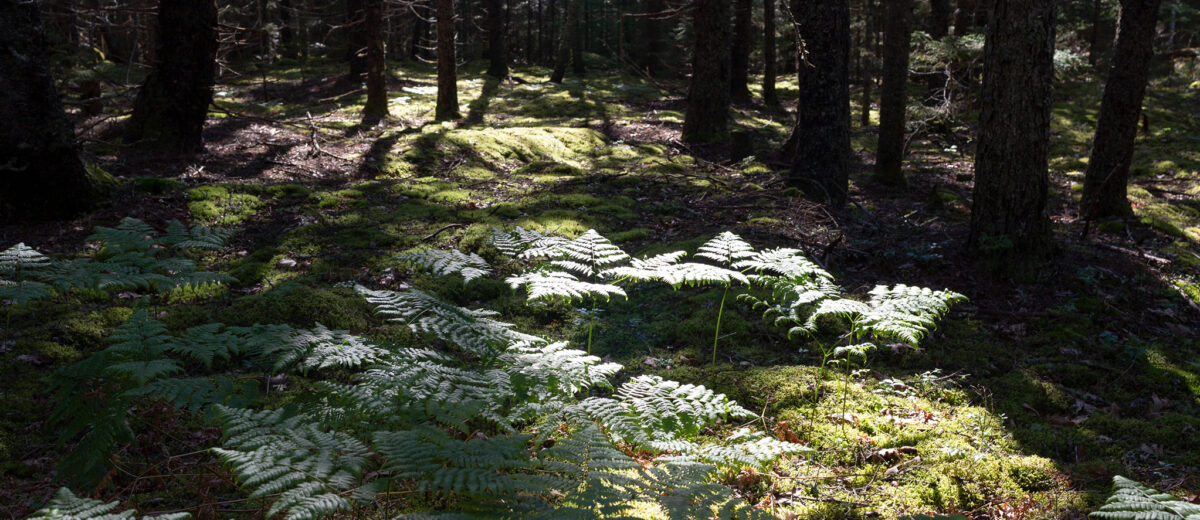by Kate Jackson
We were rambling across the boardwalk that circumnavigated Jordan Pond. The waters of the lake were crystalline, the banks edged by a grayscale of implausibly round stones; twin, humped mountains slumbered in the background. The air felt clean, and light. Occasionally, a red squirrel gave its tumbling call from among the conifers, and the galloping song of the ovenbird echoed across the forest floor.
I was abuzz, identifying plants along the trail. “Amelanchier,” I said, pointing to a shrub with toothed leaves and leaf bases that tucked into their petioles like the top of a heart. Then, an unassuming plant, growing close to the ground and with a grand total of two leaves: “Mianthemum canadense! I learned that one in Vermont – it’s flowering!!” And now a tree, adorned with small, flat needles along its branches: “Tsuga canadense. Hemlock.”
Next, I saw a little plant with a whorl of bright green leaves that met underneath a single flower. The flower was white, having four petals arranged in a plus-sign formation and a spray of yellow stamens atop. “…trillium,” I said. Bzzz, wrong! But I didn’t know that quite yet.
It was June, my first weekend in Acadia as a traveling forest monitoring technician with Schoodic Institute and the National Park Service Inventory and Monitoring Northeast Temperate Network (NETN). One of several Inventory and Monitoring (I&M) Networks throughout the country, NETN’s purpose is to survey the health of the habitats and species on national park lands, providing information to help resource managers make decisions about their parks. Prior to reaching Acadia, my crew monitored forests on the New Hampshire-Vermont border, in New Jersey, central New York, and Connecticut.
I grew up in central Virginia, the upper edge of what might be considered “the South.” As I followed the highways north, toward all the different parks we’d be sampling, I watched the plant life change. The landscape darkened with conifers. Among them aspen, to my delight, twirled their leaves like chimes. The smell was different, the very air. I wasn’t home anymore. Home, where I’d learned all my field botany. Gone were familiar plants like Rhus copallinum (winged sumac), Claytonia caroliniana (spring beauty), and the myriad of oaks I was used to. Instead, there were the conifers, and the maples, and the little plant growing next to the boardwalk at Jordan Pond.
Meet: Chamaepericlymenum canadensis. Or, as it has also been called, Cornus canadensis.

Cornus. This little plant, typically four to six inches tall and about the width of my fist – it couldn’t be related to the flowering dogwood, Cornus florida, could it? No way. Cornus florida is a tree! A tree that grows in my Virginia backyard! But yes – and a closer look makes this obvious.
Dogwoods have parallel veins that follow the curve of the leaf edge as they extend towards the leaf tip. And, surely enough, the white flower at the center of Cornus canadensis looks just like the sea of them that unfurl from Cornus florida buds, albeit a little smaller. Which means something else, too. What I’d assumed to be petals are actually bracts – modified leaves that, among other things, act as a landing pad for pollinators. What I’d assumed to be stamens are the true flowers of the plant, tiny and blooming together, clustered on the bullseye. As my weeks at Acadia progressed, Cornus canadensis plants dropped their bracts, and their bunches of tiny flowers swelled into berry-like seeds called drupes, shifting in color from green to a blushing pink (later to deepen into red). Hence one of the plant’s common names: bunchberry!

The more time I spent at Acadia, the more plants I learned. Pinus strobus (eastern white pine) charmed me with its soft sprays of blue-green needles and curved cones. I quickly got the hang of finding tiny, sweet blueberries among the foliage of Vaccinium angustifolium (lowbush blueberry). Gaylussacia baccata (black huckleberry) leaves sparkled when I turned them in the sunlight. I found the stout-needled Pinus banksiana (jack pine) growing on the granite slopes on the Schoodic Peninsula.
When I took my first field botany classes in Virginia, it was like learning a new language. Everything was a fresh discovery, and I was completely immersed in the world of plants. Northern field botany gave me this experience again, but in a new ecosystem. This experience has shown me how much more there’s left to learn. I’m eager to continue doing so.
My time at Acadia ended with a visit from my family. As we hiked through the park, I delighted in showing them my new plants. I pointed to Abies balsamea (balsam fir), Rhus typhina (staghorn sumac), Monotropa uniflora (ghost pipe). Then I crouched beside our trail, pointing to a cluster of ripening drupes that sat atop a whorl of bright green leaves. “Cornus canadensis,” I said. “Bunchberry!”
